Outdoor plumbing - features of the device
Owners of private houses and cottages, when building life support systems, often have to deal with the laying of street water supply. This system is significantly different from the familiar internal, as it works in other conditions. Below we take a detailed look at the main features of the laying of the internal pipeline.

General information
The peculiarity of the external plumbing is that the pipes are laid underground. At the same time on the street may be located valves or other elements of the water supply, for example, a plumbing outdoor column.
For these reasons, the structure of the outdoor plumbing system often raises a number of questions for beginner home craftsmen. In reality, there is nothing difficult in this, the main thing is to familiarize yourself with the main nuances of the work that are listed below in order to avoid mistakes.
The main nuances of the device plumbing
Project
Like any other construction work, it is desirable to begin the construction of a water supply system with a project.
It should display the main elements of the water supply network, such as:
- The location of the pipeline on the site;
- The location of fittings, valves;
- Connection points, etc.
The presence of such a project in the first place will allow to calculate the required number of pipes and fittings for.

Pipe selection
Having calculated the number of pipes, it is necessary to determine their type. It should be noted that the choice of pipe material is an important issue on which not only their price depends, but also the durability of the system.
Not so long ago, there was no choice as such - only steel pipes were used, but nowadays plastic pipes are usually used for outdoor plumbing, and there are several types.
The following are the features of the most common water pipes:
- HDPE (low pressure polyethylene) - recently this type of pipes is very popular, as they are not susceptible to corrosion and are quite strong, capable of withstanding pressures up to 10 atmospheres. Due to the ductility, they are easy to bend when cornering trenches. In case of freezing, these pipes do not crack.
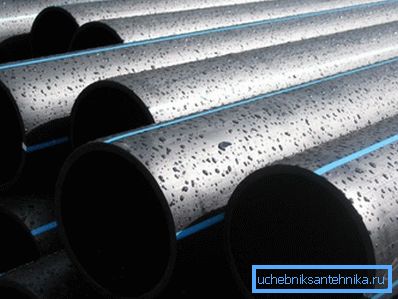
- PVC (polyvinyl chloride) - this material is characterized by increased rigidity. In addition, unlike other plastic pipes, polyvinyl chloride pipes do not deteriorate when exposed to sunlight. Therefore, they are usually used in open areas of the water supply system, for example, when you need to install an outdoor water faucet.
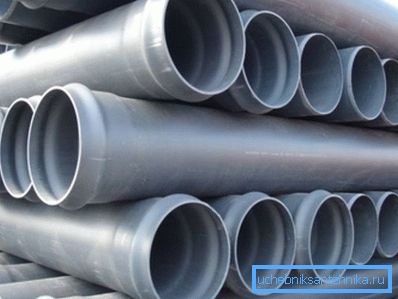
- Polypropylene - are cheaper analog of polyethylene pipes. The only thing is to install polypropylene pipes for outdoor plumbing somewhat easier due to the availability of various fittings, valves, adapters and other connecting elements.
- Steel tubes - recently used less and less, since their service life is much lower than that of plastic counterparts. This is due to the fact that they are subject to corrosion.
Note! When purchasing plastic pipes, it is necessary to make sure that they are able to withstand pressures up to 10 atmospheres, since traditionally in water supply networks the pressure can reach 5-6 atmospheres.
The important point that you need to pay attention to when choosing pipes is their diameter. This parameter depends on the number of sanitary devices that will be connected. Typically, the diameter is between 32 millimeters.

Trench depth
After the issue with the choice of pipes is resolved, it is necessary to determine the depth of the trenches on which they should be laid. To do this, refer to the SNiP, which regulates the depth of the outdoor communications.
According to these norms, the average depth of soil freezing in our country is 1.4 meters. Therefore, if you lay the pipe to a depth less than the specified, they will probably freeze.
Of course, the degree of soil freezing largely depends on the terrain. Therefore, in order to accurately know the depth, you can contact any local construction company.
Note! It is impossible to lay pipes too deep into the ground, since they can not withstand pressure, and simply crack.
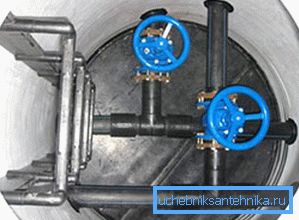
Well device
As a rule, a water well is installed near the central highway in which the taps for outdoor water supply are located. If there is an opportunity to use construction equipment, then the easiest way is to make a well from reinforced concrete rings. Otherwise, it can be laid out of brick.
The presence of the well will allow to perform emergency shutdown of the pipeline, as well as to connect additional objects to the water supply system - a bath, an irrigation system, a summer kitchen, etc. At the cottage, you can connect street taps. True, it should be borne in mind that in the winter time they will not work.
Note! The pipeline should be cut into the central highway by qualified specialists possessing the necessary equipment.
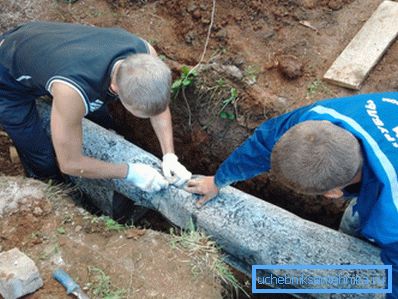
Main difficulties
As a rule, the biggest problems with the installation of a water supply system with their own hands arise in those cases when the structure of the soil does not allow to dig a trench to the required depth. In this case, you need to dig a trench to the maximum possible depth and then perform the pipe insulation.
Not so long ago, glass wool was used exclusively for insulation.
In our time, many other heat insulators have appeared, among which we can recommend:
- Polyethylene foam;
- Foam shell;
- Basalt wool;
- Polypropylene shells, etc.
When insulating pipes it is important to ensure waterproofing of the material, as well as to prevent it from being squeezed with soil. Otherwise, the entire insulating effect will be reduced to zero. Therefore, insulation, as a rule, is wrapped with a film and protected from above with a galvanized steel casing.
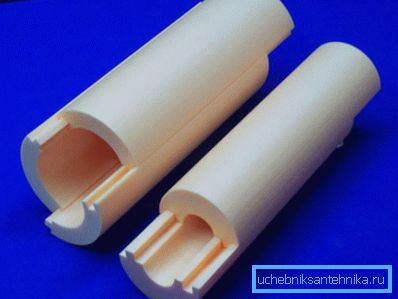
It must be said that even warming does not always help protect the water supply system from freezing in winter. For example, in places where a pipeline enters a house, as well as in those cases when it is located not deep from the ground surface, a special heating cable is used.
To reduce energy consumption, you can install a special sensor that monitors the temperature of the pipe and automatically turns on the cable. Of course, such a solution of the problem requires additional expenditure of effort, time and money, however, it will allow to operate the water supply even in the most severe frosts.
Tip! To solve the problem of freezing the pipeline of an autonomous water supply system using a well, you should use a drain valve located below the soil freezing level, which automatically drains water after each water intake.
Here, perhaps, and all the basic instructions for the installation of external plumbing. After solving all the above points, you only need to connect the pipes and fittings to each other. This process depends on the type of pipes, for example, HDPE pipes are connected using electro-couplings, and a special welding machine is used to connect the "polypropylene".
Conclusion
We reviewed the main points that will be encountered in the independent implementation of street water supply. Of course, there are some other difficulties, however, every home craftsman will be able to cope with them.
From the video in this article can be found with some additional information on this topic.